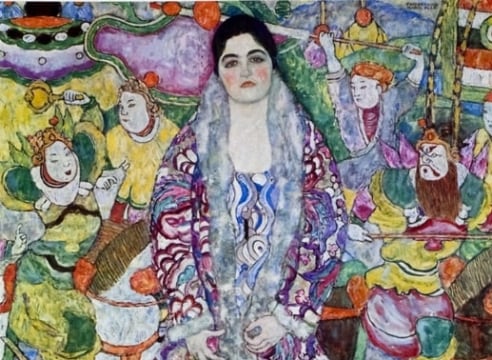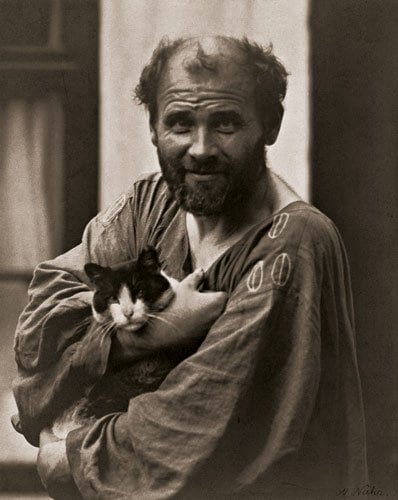

Gustav Klimt (1862 –1918) was born in Baumgarten, Austrian. His fomal career as an artist began when he was awarded a scholarship to the Vienna School of Arts and Crafts, where he studied architectural painting. From 1879 to approximately 1890, working with his brother Ernst and their friend Franz Matsch, he regualrly received important commissions for architectural paintings in the late Baroque style.
The death of his brother and father in 1892 deprived Klimt of his closest supporters and his most frequent collaborator, his brother Ernst. During this period of grief and apprehension, he began to draw upon the aesthetic vocabulary of the avant-garde. Klimt fell increasingly under the spell of contemporary art movements including Impressionism, Pointillism, and Symbolism. Klimt began to depict non-idealized figures based directly on live models, some of them prostitutes. He later met Emilie Flöge, who was to become his life-long companion despite his frequent liaisons and with other women, many of whom went on to bear his illegitimate children.
In 1897, Klimt became one of the founding members and the president of the Vienna Secession, a group of experimental artists. Around that time, Klimt was commissioned to create three paintings to decorate the ceiling of the Great Hall in the University of Vienna. “Philosophy”, “Medicine” and “Jurisprudence,” not completed until after 1900, were in his new, unconventional style. The iconography language was unfamiliar; the compositions included tangles of explicitly nude bodies and mysterious figures emerging from clouds and haze. The authorities considered them outrageous, even pornographic, and when members of the faculty petitioned to reject the murals, the scandal polarized Vienna's cultural and political factions.
By the end of the 1890s, Klimt sought a way to exhibit modern art - both fine and decorative - in an innovative setting that would appeal to Vienna's growing circle of progressive collectors. By first breaking with the monopolistic Künstlerhaus and then with official patronage, Klimt intended to build a broad-minded private clientele that would embrace his continuing stylistic development. Around 1904 he shifted his focus to portraiture, receiving a steady flow of commissions from Vienna's forward-thinking upper middle-class. Art critic Berta Zuckekandl and those who attended her salon reportedly encouraged such a break with tradition.
That same year, Klimt and twenty-three other members of the Vienna Secession parted ways with the organization, due to a growing conflict between Klimt's group (which included Carl Moll, Josef Hoffmann and others) and Josef Engelhart's. The appointment of Carl Moll as managing director of Galerie Miethke in 1905 provided alternative support for the Klimt-Gruppe, making their departure from the Secession easier, and Miethke would soon become Klimt's exclusive Viennese art gallery.
During the summer of 1908, Klimt's circle organized their first exhibition as part of the “Kunstschau 1908,” which was held in celebration the 60th anniversary of the reign of Emperor Francis Joseph I. The group was excluded from formal celebrations but permitted to build a showplace on a plot of open land in the center of the city. In short order, they erected and furnished wooden structures covering 6,500 square meters, accommodating 54 exhibition rooms, gardens, interior courtyards, a café, theater, and a completely furnished country house. Indoor and outdoor floor space, walls, and showcases were filled and covered with works by 176 artists, including Moll, Kupka, Oppenheimer and students from the Vienna School of Arts and Crafts. One room contained 16 paintings completed by Klimt between 1903 and 1908.These included some of his most important works: portraits of Margaret Stonborough-Wittgenstein, Fritza Riedler, and Adele-Bloch-Bauer (I), “Danae,” “Death and Life,” and “The Kiss—” which was immediately purchased by the Österriechische Staatsgalerie, part of the art establishment that had once rejected Klimt.
In conjunction with “Kunstschau 1908,” Klimt and the Galerie Miethke planned the publication of collotype prints under the name “Das Werk Gustav Klimts.” The first installment was ready to be introduced at the Kunstschau, thereby launching a project that would help Klimt distribute his work to a select group of collectors. Much to the excitement of all concerned, Emperor Franz Joseph, whose 60th anniversary was the focus of the year, was the first to buy the initial installment. The irony of the situation is that the first installment included depictions of the three University paintings that had been declared pornographic by the authorities and led to Klimt's "exile" from the world of public art eight years earlier.
A complete set of “Das Werk Gustav Klimts” (the Work of Gustav Klimt) contained 50 prints on heavy wove paper with deckled edges. Issued unbound, the prints were divided into five groups of ten, each of which included two polychrome images. Groups were published in separate installments over a period of six years and sold only by subscription through the publisher, H.O. Miethke. The prints depict Klimt's most important paintings dating from between 1898 and 1913. Because Klimt personally supervised the project and insisted on the proper resolution of all technical problems with the prints, the 50-piece project, which was undertaken in early 1908 was not completed until 1914.
The series uses the collotype method to its full potential, demonstrating the remarkable ability of this printing method to render gradations of tone, color and texture. All the collotype sheets and most of the images in the series are in a square format, with the remainder in the narrow rectangular format derived from Japanese paintings and woodblock pillar prints. Klimt designed a unique signet for each print, to be centered beneath the image, impressed in gold ink.
The final installment of “Das Werk” became available in 1914. Notably, as the war was winding down, Hugo Heller of Vienna was preparing to offer the complete set of “Das Werk Gustav Klimts,” as a boxed portfolio of loose prints, in an edition of 230. Because the prints in the Heller edition seem in every way exact matches to the prints in the Galerie Miethke edition, art historians speculate with a sound degree of certainty that Heller's 230 were the balance of unsold sets from the Miethke edition, preserved during the war.